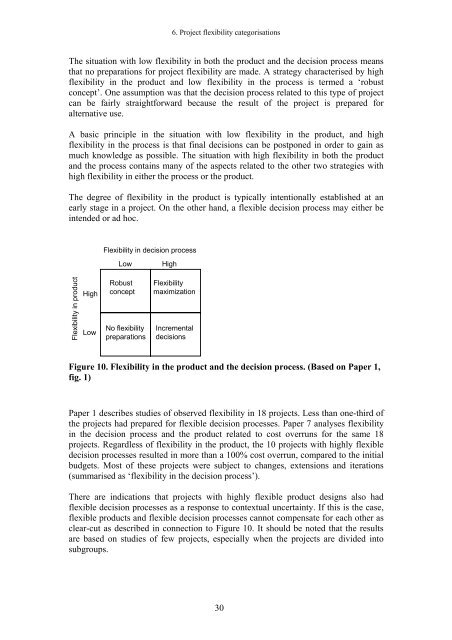Link to thesis - Concept - NTNU
Link to thesis - Concept - NTNU
Link to thesis - Concept - NTNU
Create successful ePaper yourself
Turn your PDF publications into a flip-book with our unique Google optimized e-Paper software.
6. Project flexibility categorisationsThe situation with low flexibility in both the product and the decision process meansthat no preparations for project flexibility are made. A strategy characterised by highflexibility in the product and low flexibility in the process is termed a ‘robustconcept’. One assumption was that the decision process related <strong>to</strong> this type of projectcan be fairly straightforward because the result of the project is prepared foralternative use.A basic principle in the situation with low flexibility in the product, and highflexibility in the process is that final decisions can be postponed in order <strong>to</strong> gain asmuch knowledge as possible. The situation with high flexibility in both the productand the process contains many of the aspects related <strong>to</strong> the other two strategies withhigh flexibility in either the process or the product.The degree of flexibility in the product is typically intentionally established at anearly stage in a project. On the other hand, a flexible decision process may either beintended or ad hoc.Flexibility in decision processLowHighFlexibility in productHighLowRobustconceptNo flexibilitypreparationsFlexibilitymaximizationIncrementaldecisionsFigure 10. Flexibility in the product and the decision process. (Based on Paper 1,fig. 1)Paper 1 describes studies of observed flexibility in 18 projects. Less than one-third ofthe projects had prepared for flexible decision processes. Paper 7 analyses flexibilityin the decision process and the product related <strong>to</strong> cost overruns for the same 18projects. Regardless of flexibility in the product, the 10 projects with highly flexibledecision processes resulted in more than a 100% cost overrun, compared <strong>to</strong> the initialbudgets. Most of these projects were subject <strong>to</strong> changes, extensions and iterations(summarised as ‘flexibility in the decision process’).There are indications that projects with highly flexible product designs also hadflexible decision processes as a response <strong>to</strong> contextual uncertainty. If this is the case,flexible products and flexible decision processes cannot compensate for each other asclear-cut as described in connection <strong>to</strong> Figure 10. It should be noted that the resultsare based on studies of few projects, especially when the projects are divided in<strong>to</strong>subgroups.30
















